Nagano
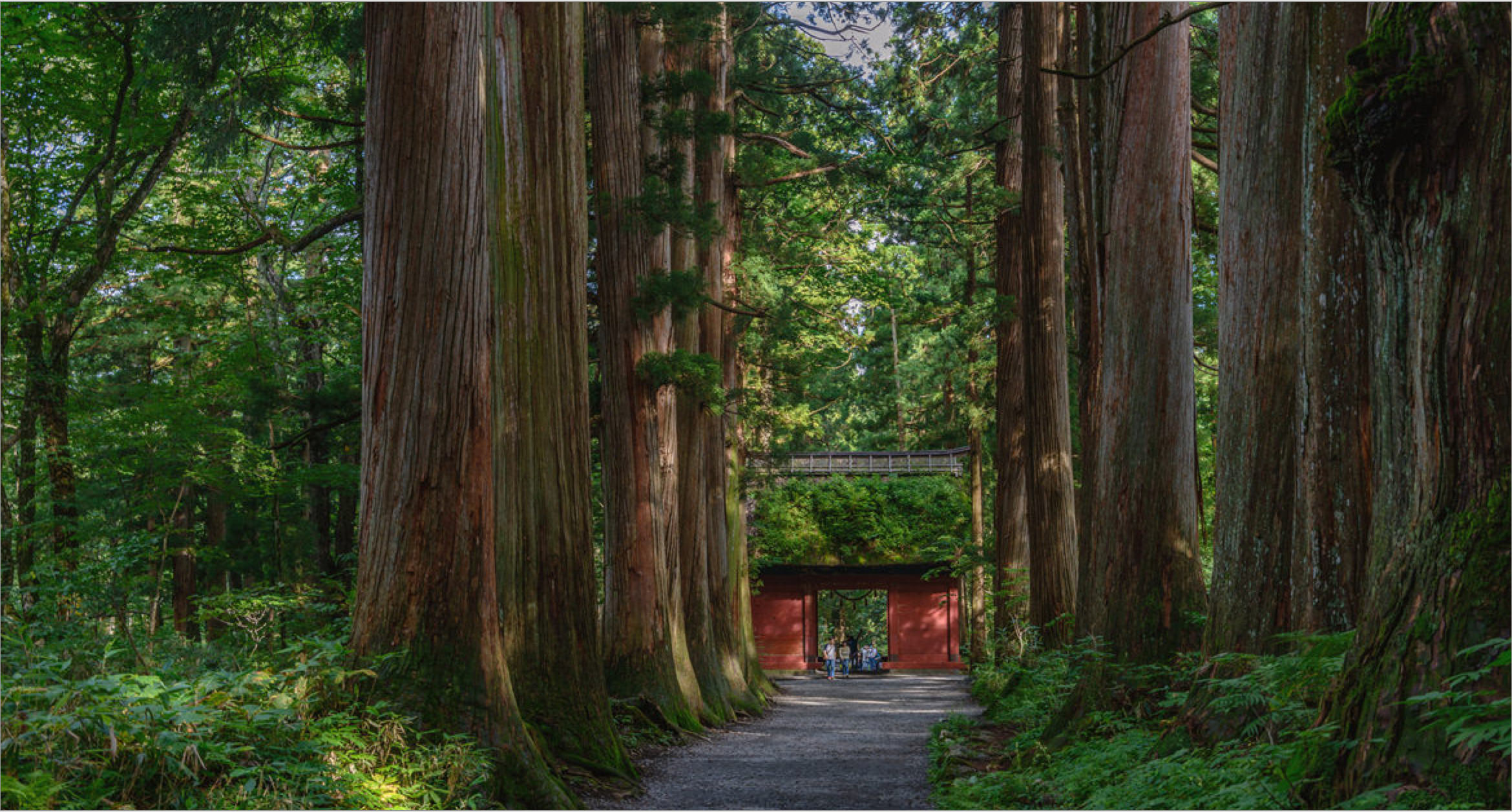




- Home
- Destinations
- Nagano
A city full of history, culture and nature
Visit the home of countless temples and shrines, and follow the footsteps of samurai in a historic town.
The entire region of Nagano City is alive with amazing natural beauty, spiritual beliefs and rich history dating back to the ancient times. Visit Zenkoji Temple, the heart and soul of the locals, or wander around the lush greenery of the sacred Togakushi area. Additionally, you can opt to take a tour around a variety of historical sites in Matsushiro. Come to Nagano for a journey you will never forget!
The Area


Nagano
Togakushi
Matsushiro

-
Zenkoji Temple
- With a long history of about 1400 years since its construction, Zenkoji Temple houses the Amida (Nyorai) Triad as a main devotional object within its grounds, which is said to be the oldest Buddha statue in Japan. Welcoming people from all walks of life regardless of religion or sex, the temple is so famous and important that it has been said since olden times that one should visit Zenkoji Temple at least once in their life. The current main hall has been reconstructed in 1707 and has been designated as a National Treasure for its Buddhist architecture that represents the mid-Edo Period.

-
Seson-in Shakado Temple
- The Seson-in Temple is one of the 25 Tendai sect temples at Zenkoji Temple and is used as a temple lodging facility. It is also referred to as “Shakado” as the main hall houses a statue of Shakyamuni Nirvana. When or how the temple was founded is unknown, but the reclining Buddha statue in the main hall was made in the Kamakura Period and is said to be the only life-sized Buddha statue. It is definitely worth stopping by here when visiting Zenkoji Temple.
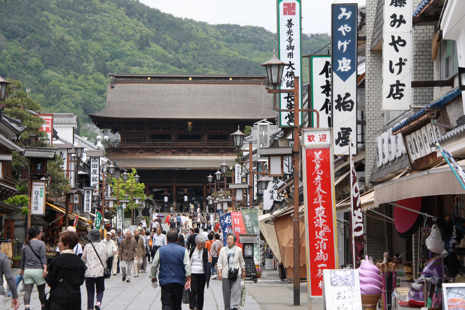
-
Nakamise Street
- Nakamise Street is a stone-paved street that goes from the Zenkoji Temple precinct entrance all the way to the main hall. Designated as a cultural asset of Nagano City, the street is said to have been made from exactly 7,777 stones and has been supporting the feet of pilgrims since the mid-Edo Period. It is a quaint street and a must-visit place where you can eat Nagano’s local specialties and do some souvenir shopping as souvenir shops, restaurants and temple lodgings line both sides of the street.
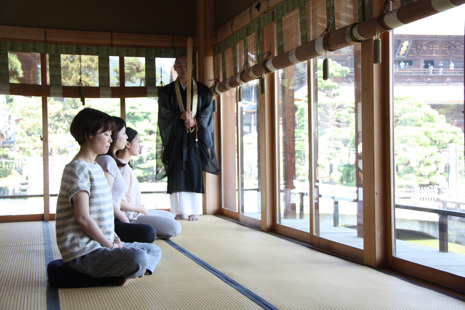
-
Temple Lodging Experience
- There are a total of 39 temple lodgings at Zenkoji Temple and each has its own temple and priest. Boasting a long tradition, each temple lodging welcomes you with a unique atmosphere and distinct features. In addition to lodging, there are a variety of Japanese cultural activities and experiences that you can partake in such as a Buddhist rosary making, zazen meditation, sutra copying and vegetarian cooking lessons. Visit the faith-filled Nagano and make your trip the most fulfilling and memorable it can be with a temple lodging experience.

-
Traditional Craft Making
- There are many shops and facilities along Nakamise Street near Zenkoji Temple where you can try your hand at traditional Japanese craft making such as rosary, kaleidoscope and sachet making. These activities can be enjoyed by adults and small children alike and are very popular throughout the entire year, as you can spend some time relaxing here whether it is a sunny day or a rainy day. Instead of just buying a regular souvenir at your travel destination, how about making one of your own that captures all the memories of your trip to Nagano?

-
Ninja Daimon
- Ninja Daimon used to be an old private house founded in the Meiji Period along Zenkoji Omotesando that has been renovated into a ninja-themed amusement shop where you can do some shopping, eating and playing. It's a sightseeing spot that brings joy, especially to children, with play spaces where you can try your hand at shuriken throwing or shooting darts from a blowpipe. Anyone planning on visiting Zenkoji should definitely stop by this place as well, as there are many things that adults can also enjoy such as ninja-themed food and merchandise.

-
The Avenue of Ancient Cedar Trees
- The path from the bus stop to the Okusha Shrine is about 2km long and in the middle of it stands the red-lacquered Zuishin Gate followed by dozens of 400-year old cedar trees on either side of the path that have been designated as a national monument. The power of the trees has not faded over time and it still retains the divine nature of the path to this day. In the beginning of winter or spring, you can witness a mysterious sight as the sun rises straight along the path.

-
Togakushi Ninja Museum & Ninja Trick Mansion
- This place consists of three facilities in total that can be enjoyed by children and adults alike. There is the Togakushi Folk Museum and Togakushi Ninja Museum which store and display around 2,000 items, including tools that were used by ninjas as well as everyday goods that supported the traditional climate and way of living in Togakushi in the olden days. Besides that, there is also a Ninja Trick Mansion where you try to find the exit as you climb up staircases and pass through mazes and ninja rooms.

-
Okusha Shrine
- In Japanese mythology, the Sun Goddess Amaterasu once hid in a heavenly cave (Ama no Iwaya), but was forced out again by the God of Strength Ama no Tajikarao who opened the cave’s door with his unparalleled godly power and threw it all the way to Togakushi. Thus, Ama no Tajikarao came to be enshrined here at the foot of Mt. Togakushi. Okusha Shrine is the main shrine of Togakushi and its divine virtues such as good fortune, wish fulfillment, abundant harvest and sport victories have been spread throughout the country which led to many people worshipping the shrine.
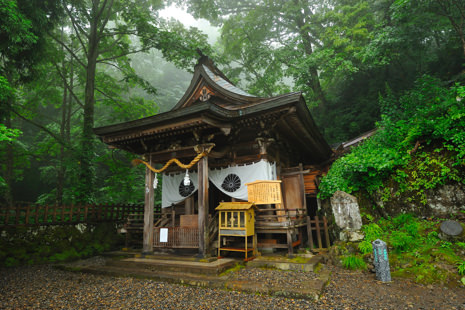
-
Kuzuryusha Shrine
- The Kuzuryusha Shrine which sits next to the Okusha Shrine has been a central presence within the Togakushi faith as it houses a local deity since the olden days. While the exact date of enshrinement is unknown, the local deity’s enshrinement happened before Ama no Tajikarao was enshrined in the Okusha Shrine. Kuzuryusha Shrine’s deity rules over water, which is the source of life, and has been worshipped as the God of Rainmaking as well as the God of Dental Caries and Matchmaking.
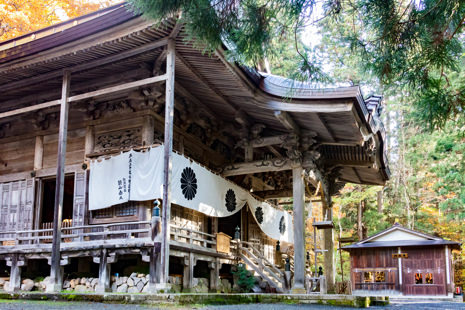
-
Hokosha Shrine
- Among the old cedar trees, at the top of a flight of 270 stone steps, you can find the mystic Hokosha Shrine which is a remnant of a time when Shintoism and Buddhism were taught together. It is the oldest shrine among the five shrines in Togakushi and was built during the late Edo Period. The carving of the worship hall was done by shrine/temple master carver Kiyomatsu Kitamura and is simply amazing. The enshrined deity is Ame no Uwaharu no Mikoto who holds divine virtues such as family safety and protection for women and children.

-
Hinomikosha Shrine
- Founded around the year 1098, the Hinomikosha Shrine’s main deity is Ama no Uzume, the goddess who danced in front of the sacred cave, and besides her three other gods are praised here. Even at the time when Shintoism and Buddhism were still taught together, this is the only place that was constantly regarded as a shrine for Mt. Togakushi’s gods. The grand kagura dance of the Togakushi shrines has been taught since ancient times by the priests of this shrine. The enshrined deity here is revered as the God of Performing Arts, the God of Matchmaking and the God of Fire Prevention.

-
Chusha Shrine
- Enshrined within the Chusha Shrine is the God of Wisdom Ame no Yagokoro Omoikane no Mikoto, who devised the plan to do a sacred dance called kagura which helped open the door of the heavenly cave. On its grounds there stand three cedar trees that are about 800 years old and many worshippers come to visit the shrine. There are times when you can watch the performance or a practice session of a grand kagura dance being held in the kagura hall of the shrine.

-
Kagami Pond
- Kagami Pond (Mirror Pond) is a quiet pond at the foot of the Togakushi mountain range. As its name suggests, if the weather conditions are good, you can see the Togakushi mountain range reflected on the water surface like a mirror. The leaves of the trees around the pond and on the mountains will turn red or yellow during autumn, usually from early to mid-October. It's a popular spot where many tourists come to visit during autumn or in the early morning when there's no wind. We recommend the nice 30 min. walk from the Okusha Shrine to Kagami Pond.

-
Matsushiro Castle Ruins
- Matsushiro Castle was built during the Sengoku Period by Kansuke Yamamoto under the orders of Shingen Takeda to prepare for an attack by Kenshin Uesugi. It is a natural fortress that used its natural geography to its advantage as it stood close to the Chikuma River. After Nobuyuki Sanada moved in from Ueda Castle as lord of the Matsushiro Domain in the Edo Period, ten generations of the Sanada clan ruled over the area as lords of the castle. Each year around mid-April, it becomes a popular cherry blossom viewing spot.

-
Matsushiro Underground Imperial Headquarters
- At the end of the Second World War, the army excavated an underground bunker in Mt. Maizuru, Mt. Minakami and Mt. Zozan in secret under the plan to move the Imperial Headquarters and the government agency to Matsusuhiro as the final strong point for decisive battles on the mainland. The Matsushiro Underground Imperial Headquarters has a total length of 5,853m, with around 500m being opened to the public.

-
Bunbu School
- Opened in 1855 near the end of the Edo Period, the Matsushiro Domain Bunbu School (or Old School for Literary and Military Arts) taught Western military studies in addition to literature and martial arts. It is interesting to compare the school building to modern ones, as there are various differences such as the general classroom being a literary room, the gymnasium being a sword fighting or martial arts practice room and the library being an archive, et cetera. At that time, advanced education, such as the teaching of Western medicine instead of Confucianism, was offered.

-
Chokokuji Temple
- As the family temple for the Sanada clan, the lords of the Matsushiro Domain, the roof of the temple features the Sanada family crest, the "rokumonsen" (six one-mon coins). In addition to the tombs of the successive lords of the domain, the mausoleums of Nobuyuki and Nobuhiro are there as well. Nobuyuki's mausoleum is an important cultural asset with sculptures of cranes on its gables. Legend says that those cranes broke from the gables and devoured the rice plants night after night. The paintings on the ceiling are said to be the work of famous painter Kano Tan-yu.

-
Sanada Treasure Museum
- The Sanada Treasure Museum opened as a museum that stores and displays items of feudal lords such as armor, furniture, paintings and calligraphic works, and documents that were handed down by the 12th head of the Sanada clan, Koji Sanada. There are about 50,000 valuable materials kept here such as the national important cultural property “Aoe no Otochi” (samurai sword), Yukimura Sanada's "Noborihashigo no Gusoku" (body armor), and letters written by Shingen Takeda, Hideyoshi Toyotomi, Mitsunari Ishida, Ieyasu Tokugawa, and more.
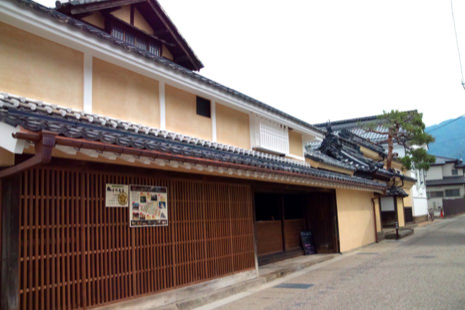
-
Teramachi Merchant Residence
- The Teramachi Merchant Residence (former Kanebako Family Residence) is the former residence of the Kanebako Family, a merchant family, that ran a pawnshop in Matsushiro from the late Edo Period to the start of the Showa Period. There are historic buildings as well as a garden with a spring waterway and pond, that show the merchants' lifestyle from the Meiji to the Taisho Period. It was designated as a Tangible Cultural Property of Nagano City in 2012. You can also enjoy some food made with local produce by local chefs inside the historic building.

-
Sanada Family Residence
- At the end of the Edo Period, Sanada Yukinori, the 9th lord of the Matsushiro Domain, built the house as a retreat for his mother-in-law Teishoin, which eventually also became his retreat after he retired. Since the Meiji Period, it functioned as the private residence of the Sanada Family. In addition to the main building (the palace), the front gate, and 7 storehouses, the garden was left as an integral part of the site. It is a valuable building that has remained as it was at the time, and strongly conveys the image of a samurai residence.
Transport RoutesTransport RoutesTransport Routes



Timetables and Reservations
/ TDR
Nagano Station Bus Terminal Map


Discounted Tickets
Q & A
It's about 2 km from the Nagano Station Zenkoji Exit until Zenkoji Temple, which takes about 30 min on foot. There is also a route bus going to Zenkoji Temple from the Nagano Station Zenkoji Exit every 5 to 10 min., so please use the bus if you like.
As Nagano City is located in a lower altitude area, the best time to see the cherry blossoms is from mid to late April.
For Togakushi, the best time to see autumn foliage is from the middle to the end of October. Within the city (Seisuiji Temple etc.), the foliage is at its best from early to mid/late November.
English-speaking guides are available. There is the Nagano City Guide Association and the SGG Club "Bonsho no Kai". The SGG Club "Bonsho no Kai" is the only volunteer guide group that may guide within the grounds of Zenkoji Temple. For more information, click here.
From the bus stop to Zuishinmon Gate will take about 20 min on foot, and from Zuishinmon Gate to the Okusha Shrine will take another 20 min.
You can go there in winter, but there may be times when you can't go due to the amount of snow that has fallen. You would also need snow shoes. As the bus does not stop at Togakushi Okusha during winter time, please get off at the Togakushi Chusha bus stop.
There are several soba restaurants and other places to eat within the vicinity of the Chusha Shrine. There are also 2 soba restaurants near the Togakushi Okusha bus stop.
While the shrines are open throughout the year, the Kids Ninja Village, the Togakushi Folk Museum, the Togakushi Ninja Museum and the Ninja Trick Museum are closed from December until March due to snow. Please inquire for more details at each facility directly.
The best time to see the autumn foliage is from mid to late-October.
Yes, there are.
1. Matsushiro Tourist Information Center
- 18 bicycles for adults, 500 JPY a day (from 9:00 until 16:00)
- 3 bicycles for children, 500 JPY a day (from 9:00 until 16:00)
2. Royal Hotel Nagano
- 3 electric bicycles, 1,500 JPY a day (500 JPY if within 2 hours)
3. Matsushiro Machiaruki Center (closed on Tuesdays and during the New Year's holiday)
- 3 bicycles, 800 JPY a day (400 JPY for half a day)
- 3 electric bicycles, 1,200 JPY a day (600 JPY for half a day)
With a rental bicycle you can do it in about 2 hours. On foot, it will take about 4 hours (half a day).
It's about 1.2 km from the Information Center, which takes 20 min. on foot and 5 min. by bicycle. There is no entrance fee. Write your name down on the paper at the management office counter near the entrance, and put on one of the helmets there that fits you before entering.
The best time to see the cherry blossoms of the Matsushiro Castle Ruins is around middle of April.
The best time is usually from early to mid-April.
English-speaking guides are available. You can request a guide from the Matsushiro Volunteer Guide Association.















